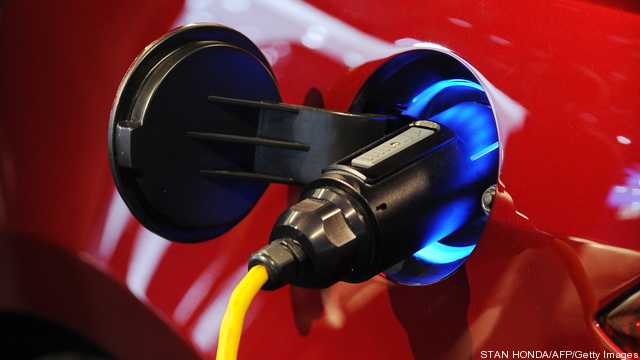Our Home Energy Reports in Action – Duke Energy’s path to a more engaged, energy efficient and loyal utility customer: http://bit.ly/HLrvoP Tendril
Smart Grid
Our Home Energy Reports in Action – Duke Energy’s path to a more engaged, energy efficient and loyal utility customer: http://bit.ly/HLrvoP
By Peter GardettSign up and get Breaking Energy news in your inbox.
We will never sell or share your information without your consent. See our privacy policy.
Ontario’s largest power distributor – Hydro One – is looking to transform the province’s aging electrical system into a state of the art power delivery network. The utility recently selected IBM and Telvent to lead the charge toward a more energy efficient and reliable 21st century power grid.
Built in the 1950’s, Ontario’s electric grid took a centralized approach to power delivery, but the changing nature of electricity generation and transmission, with distributed sources becoming more prevalent, requires a more versatile grid design. Keep reading →

When talking about energy and power generation today, it’s hard to avoid the topic of smart grids and intelligent metering systems. But the subject can seem somewhat nebulous and perhaps idealistic without hard numbers that put things in perspective. That is exactly what the US Energy Information Administration does.
The EIA maintains granular smart meter data that includes the total number of installations, who has them and more. At the end of 2010, 663 utilities had over 20 million advanced metering infrastructure installations, which accounts for about 6% of the total current US population. The lion’s share of these installations are at the residential level. Keep reading →
 The charging cord for the Tesla Model S electric car
The charging cord for the Tesla Model S electric car
There is a hidden barrier to electric vehicles (EV) adoption – our electric grid. EVs could significantly increase peak demand and thus impact grid reliability. AMI and demand response technologies are often promoted as the solution for this uptick in peak demand. But we also need to look at other, grid-based solutions to enable broader adoption of EVs. Here are a few reasons why: Keep reading →

In today’s interconnected energy world, it’s not easy for islands and remote communities, cut off from the ready energy supply of big grids, pipelines and superhighways. Witness the international drama last winter when Nome, Alaska became ice-locked and only secured fuel because of an elaborate sea effort by Russia and the US.
Dependent on the outside world for fossil fuels, places like Nome face not only shortages, but also sky-high energy prices. Some residents of Nome spend 45% of their income on energy. Similarly, Hawaiians pay more than twice as much for electricity as Californians. Keep reading →

Will low-cost Chinese meters eventually force out equipment made in the U.S. and Europe? Earlier this year, we saw China-affiliated Glen Canyon launch an inexpensive smart meter for the North American market. But most analysts predict it will take a few years – at the earliest – for Chinese meters to penetrate the staid and slow-to-change market here.
A more grave threat may be embodied in Monday’s announcement (see the press release) that Chinese giant Huawei is teaming with Landis+Gyr to attack the UK market. Most U.S.-based metering companies have long assumed that Europe would provide their next wave of growth. But European utilities may prove more willing to incorporate Chinese technology. At best, the North American companies will have to slash prices and margins. At worst, they could be priced out altogether. Keep reading →
 Traders on the floor of the New York Stock Exchange March 21, 2012 just after the opening bell.
Traders on the floor of the New York Stock Exchange March 21, 2012 just after the opening bell.
There seem to be few limits to the number of risks that can circle any new energy project, whether it be an oil well or an efficiency-boosting technology designed for the home. From politics to privacy to financing to a lack of metrics, the obstacles often inhibit needed investment in the US and abroad as infrastructure ages while global demand grows. Keep reading →

IT is poised to revolutionize the energy industry by ceding control of consumption and generation to consumers and lead to an “age of empowerment”, an influential figure in the wholesale power sector said yesterday.
David Crane, the outspoken CEO of NRG Energy, told the Cleantech Forum in San Francisco: “We’ve come a long way from the days of the legendary Henry Ford and his comment that the American consumer can have any color of model T as long as it’s black. Keep reading →

For the average residential customer, there’s a lot of confusing information out there about smart meters. Much of the discussion around the smart grid focuses on how advances in technology will benefit utilities.
While it’s true that a self-healing grid will bring shorter, less frequent outages and that smart meters can help make the electrical grid more efficient, most customers view reliability of electrical service as a given, not a benefit. In order to increase customer acceptance and adoption of advanced metering technology, the personal benefits need to be framed in ways that resonate with residential customers. Keep reading →

Utilities converting to smart meters must find out how the new technology creates value for their customers, and not just financial value, experts told the Edison Foundation’s Powering the People 2.0 conference in Washington, DC March 22.
Utilities nationwide are wrestling with how to get customers to buy into the potential the new technology offers. Smart meters have met resistance from customers citing privacy worries, claims of health issues from the meters’ communication chips, and charges the devices are a subterfuge to raise electricity prices. Keep reading →
